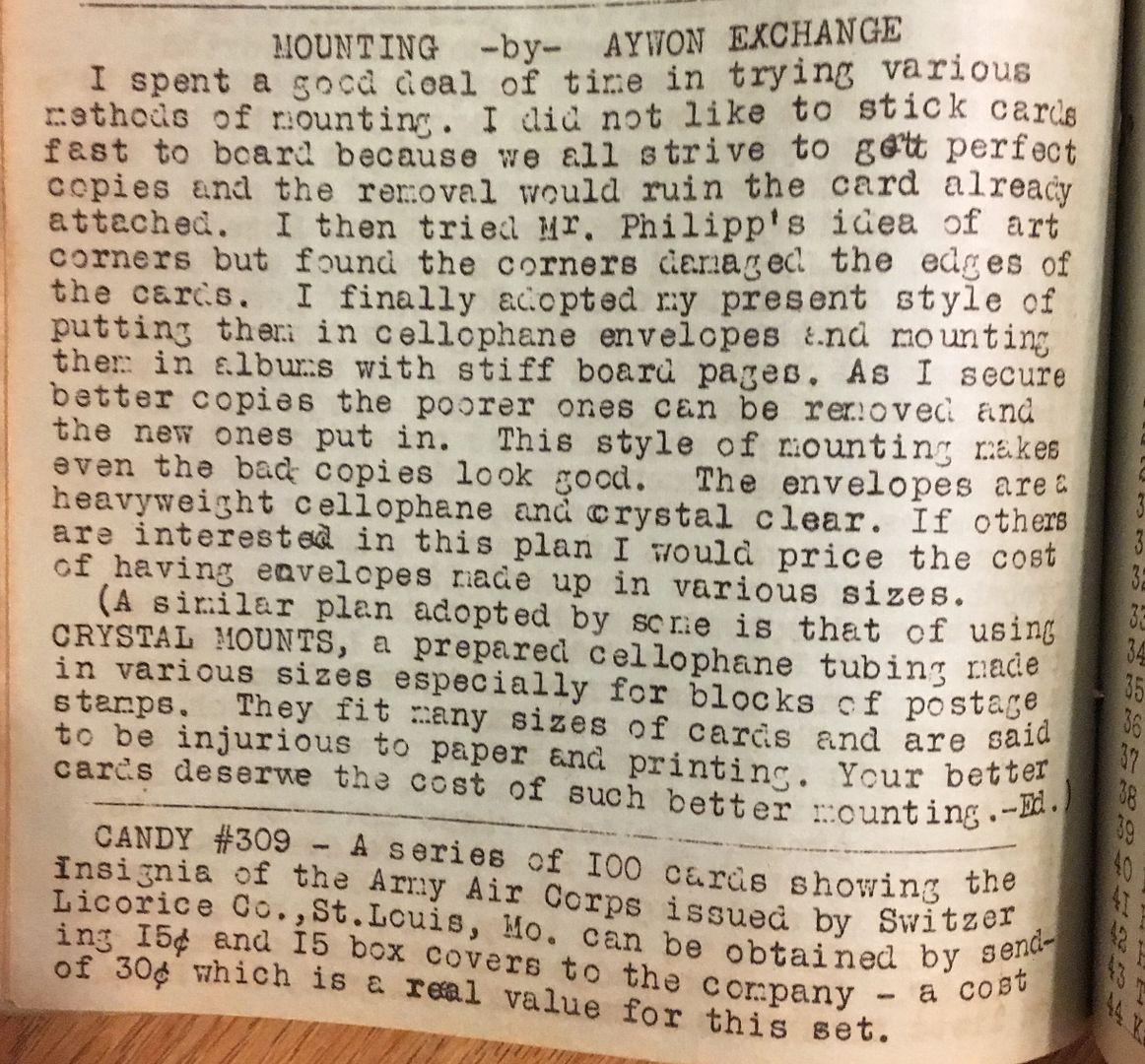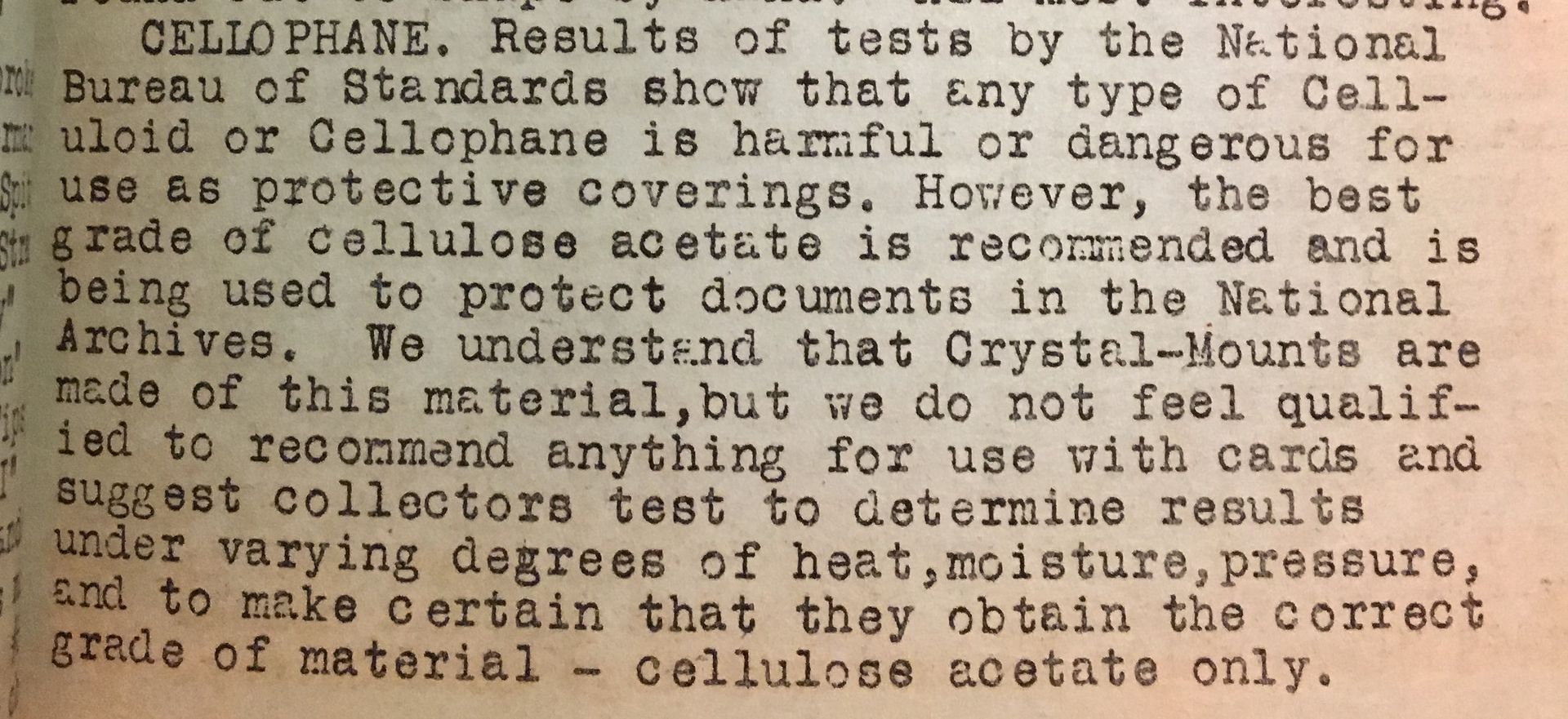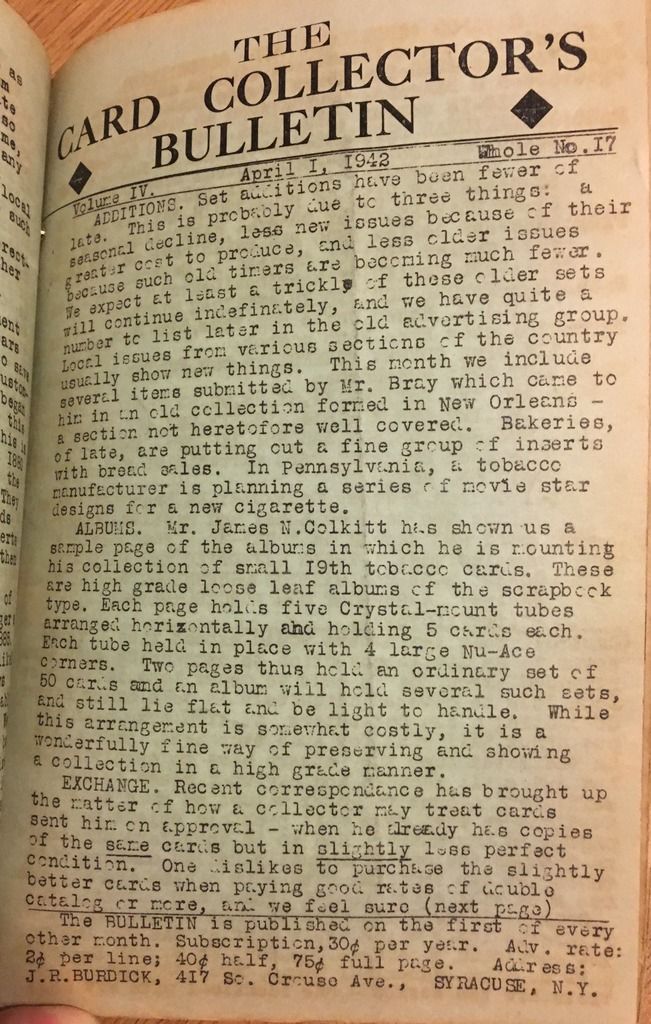|
|
#1
|
||||
|
||||
|
At what point will we start to see the residual effects, if any, of our cards in slabs?
__________________
Just a dad trying to figure out how to build a collection his kids will take interest in. Interests: HoF, Grover Hartley, Cleveland, Jim Thome, Jose Ramirez, Akron Zips, Historically Significant Figures Cooperstown Project Progress: 177/351 - 50.43% Follow along and see what I need here. Last edited by KMayUSA6060; 07-11-2017 at 12:01 PM. |
|
#2
|
||||
|
||||
|
The baseball hall of fame has concerns:
Quote:
To be fair they did go on to say that it also has to do with the amount of space the slabs take. Here is a thread that was started when that article came out: http://www.net54baseball.com/showthread.php?t=223468
__________________
https://www.flickr.com/photos/bn2cardz/albums |
|
#3
|
||||
|
||||
|
I am sure our slabs are made of nearly inert plastics. Stored indoors, out of light, not in a humid cellar, I would think they would be fine for a very long time.
__________________
Net 54-- the discussion board where people resent discussions.  My avatar is a sketch by my son who is an art school graduate. Some of his sketches and paintings are at https://www.jamesspaethartwork.com/ |
|
#4
|
|||
|
|||
|
Yeah what's the worry exactly? Has there been any instance of a card being damaged while inside of a holder by the holder?
|
|
#5
|
||||
|
||||
|
Quote:
Just got another one like that, and am debating returning it or getting SGC to re-slab it (hopefully at no charge) at the next National. The card slid over the gasket and got jammed under the label. When un-jammed, the corner became nicked with a tiny piece of paper loss!  This was, unfortunately, a very nice tobacco era card...my reasons for keeping it, if I decide to, are that I still like the card, the damage won't affect the "Authentic" grade, and most importantly, I'm afraid that shipping the card will damage it further (it's what caused this in the first place). Last edited by sterlingfox; 07-12-2017 at 08:04 AM. |
|
#6
|
||||
|
||||
|
Quote:
The main reason for my question is grading is still relatively new, all things considered, and I've never heard of any of the companies stating what their slabs are made of, or what technology is used to insure the ultimate protection beyond the obvious holder. I don't know exactly when the first "slab" came around, but say we're in year 20. What if by year 30, we find out the plastics are corrosive? It could be too late for some cards.
__________________
Just a dad trying to figure out how to build a collection his kids will take interest in. Interests: HoF, Grover Hartley, Cleveland, Jim Thome, Jose Ramirez, Akron Zips, Historically Significant Figures Cooperstown Project Progress: 177/351 - 50.43% Follow along and see what I need here. |
|
#7
|
||||
|
||||
|
Quote:
"The practice of slabbing began recently enough that there is not a long enough track record to be certain that damage will not result over time." Plastics have been seen to destroy other artifacts over a long period of time. At this point the concern comes from the uncertainty of these plastics.
__________________
https://www.flickr.com/photos/bn2cardz/albums |
|
#8
|
||||
|
||||
|
Relative (emphasis intentional) to other ways of storing-- including other ways you would store the particular card--, I think the slabs are okay. If you put it in a penny sleeve and top loader you aren't certain how it will be in thirty years either.
Last edited by drcy; 07-12-2017 at 11:13 AM. |
|
#9
|
|||
|
|||
|
Not sure if this would apply to cards that have spent many years encapsulated, but I was watching a documentary many years ago on PBS, if memory serves, and they had several medieval books that had been stored for years with very little or no exposure to air. The moment they were taken out of that environment they actually started to disintegrate and crumble. I don't remember if they were composed largely of vellum or actual paper?
Last edited by NewEnglandBaseBallist; 07-12-2017 at 11:16 AM. |
|
#10
|
||||
|
||||
|
The major cause of damage to cards is physical handling-- so you if you're taking cards in and out of various holder systems regularly, the physical handling is the biggest potential source.
A serious study of holder, materials etc would be excellent for the hobby, but I think keeping a card in a holder/penny sleeve in dry/dark conditions is good. As a side note, I got a storage rooms tour of the Chicago History Museum by the head historian, and they have different environmental conditions for different things. Photos are stored in different conditions than say medals. The highlight of the tour was the bed Lincoln died on. It had what they believed were his blood stains, but they weren't willing to do a DNA test yet until it could be done by taking only a very small piece of the cloth (the current required amount of cloth isn't to their liking). Though he said with scientific advancement he assumed it would be done in the near future. Last edited by drcy; 07-12-2017 at 11:27 AM. |
|
#11
|
|||
|
|||
|
The damages you guys mentioned are from the card not being properly secured within the holder, not damage caused by the holder being made of plastic. Before slabs I used pocket pages and smaller cases, they were made of plastic as well.
Last edited by packs; 07-12-2017 at 11:29 AM. |
|
#12
|
|||
|
|||
|
I've had doubts about the slabs myself.
I believe most are polycarbonate (lexan) which is halfway decent, and has some UV blocking ability. The sleeves when used are either Mylar - excellent. Or polypropylene, also a fine choice. While I like SGC for looks, I'm not so sure about the gasket. Acid free is possible but the details aren't known. The idea I had early on was that for cards on acidic paper like strip cards, and most Topps and Bowman, the slab might seal in the acid from the cardstock degrading. And that would accelerate the process. I actually asked SGC, and their slabs are not airtight, so there may be enough transfer of air to prevent that. I do think some study and/or some transparency about materials from the grading companies would be a fine thing. Steve B |
|
#13
|
||||
|
||||
|
I'm surprised, with how much money is thrown around in the hobby, there hasn't been a study on storage materials/slabs. We're in a unique hobby, because each and every one of us is a historian. We are guardians of pieces that tell the history of not only the sport of baseball, but also the United States and sometimes world as a whole. I would think people would want to know more about how to keep these items safe for the long haul.
__________________
Just a dad trying to figure out how to build a collection his kids will take interest in. Interests: HoF, Grover Hartley, Cleveland, Jim Thome, Jose Ramirez, Akron Zips, Historically Significant Figures Cooperstown Project Progress: 177/351 - 50.43% Follow along and see what I need here. |
|
#14
|
||||
|
||||
|
This thread has some good technical discussion at the end: http://net54baseball.com/showthread.php?t=91156&page=2
|
|
#15
|
||||
|
||||
|
Quote:
__________________
Just a dad trying to figure out how to build a collection his kids will take interest in. Interests: HoF, Grover Hartley, Cleveland, Jim Thome, Jose Ramirez, Akron Zips, Historically Significant Figures Cooperstown Project Progress: 177/351 - 50.43% Follow along and see what I need here. |
|
#16
|
||||
|
||||
|
Believe it or not, this issue -- of cards being potentially damaged by clear materials meant to preserve them -- was being written about by Jefferson Burdick in the early 1940s. The first item below appeared in the October 1, 1941 issue of Card Collectors Bulletin, in which Aywon Exchange discusses the use of cellophane envelopes mounted on album pages to hold cards, and Burdick adds an editor's note recommending instead the use of Crystal Mounts, which were made for blocks of stamps. (I assume Burdick accidentally omitted a "not" when he wrote that they "are said to be injurious to paper and printing".) The second item below appeared in the next issue of CCB, dated December 1, 1941, and in it Burdick warns that ordinary cellophane can damage cards, but that cellulose acetate, which was used to make Crystal Mounts, is safe. The last item, which I previously showed in my post on James Colkitt and the auction of his collection, is from two issues later, the issue of April 1, 1942. It describes how Colkitt was using Crystal Mounts on scrapbook pages to mount his collection of 19th century tobacco cards; Burdick heartily approves, and I suspect that either he told Colkitt about this method, or Colkitt read about it in Burdick's CCB articles and decided to try it.
In any case, the idea of mounting collections of cards in an album, protected by a clear layer of protection, pretty much faded away after the 1940s, though it never totally went away. Plastic sheets made for baseball cards came on the market in the mid-1970s and immediately became very popular, but it turned out that the first generation of plastic pages contained PVC, which could damage cards over periods of many years. I remember around 1980 when this became widely known in the hobby, and everybody was scrambling to get plastic pages with "No PVC".   
|
|
#17
|
|||
|
|||
|
Oddly enough, cellulose acetate isn't really used anymore. The primary use was photo film. Under certain conditions it can degrade and give off acetic acid as it does. It also shrinks.
Crystal mounts were the thing for the better stamps when I was a kid, but haven't been used for a long time now. Interesting to see that the national archives used it even knowing it wasn't all that great. It's probable there just wasn't anything better. Polypropylene and Mylar didn't come along until the mid-late50's, |
|
#18
|
||||
|
||||
|
Sometimes properly slabbed cards are still damaged by the holders.
__________________
Collection: https://www.flickr.com/photos/132359235@N05/sets/ For Sale: https://www.flickr.com/photos/132359...7719430982559/ Ebay listings: https://www.ebay.com/sch/harrydoyle/...p2047675.l2562 |
|
#19
|
||||
|
||||
|
They absolutely get damaged in slabs - especially in SGC slabs (even one's with a functioning gasket!)

|
|
#20
|
||||
|
||||
|
Bryan- It is sort of hard to tell if the card was damaged, to me, by those scans. Is it more obvious in person?
For me, slabs protect the cards better than no slabs.... .
__________________
Leon Luckey www.luckeycards.com |
|
#21
|
||||
|
||||
|
Remember the vinyl smell of those '70s - early '80s era sheets?
|
 |
|
|
 Similar Threads
Similar Threads
|
||||
| Thread | Thread Starter | Forum | Replies | Last Post |
| psa and sgc holders - how protective of the cards inside | jsq | Net54baseball Vintage (WWII & Older) Baseball Cards & New Member Introductions | 11 | 12-08-2015 08:37 PM |
| Cracking a protective case | Archive | Net54baseball Vintage (WWII & Older) Baseball Cards & New Member Introductions | 32 | 04-24-2012 11:25 AM |
| Infomation on Graded Tall Boy protective bags | smtjoy | Net54baseball Vintage (WWII & Older) Baseball Cards & New Member Introductions | 11 | 08-12-2009 02:56 PM |
| BVS Slabs | Archive | Net54baseball Vintage (WWII & Older) Baseball Cards & New Member Introductions | 13 | 05-23-2008 09:20 AM |
| Protective Pages for SGC/PSA???? | Archive | Net54baseball Vintage (WWII & Older) Baseball Cards & New Member Introductions | 9 | 04-09-2006 06:41 PM |